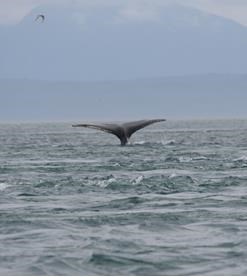Last updated: February 19, 2018
Article
Helping cruise ships and other mariners detect and avoid whales in Glacier Bay National Park
By Jennifer E. Helm, Sara H. Williams, and Paul M. Lukacs (University of Montana) and Scott M. Gende (National Park Service)
Project Dates
May 2016 — September 2017
Did you know?
Whales are susceptible to collisions with marine vessels, which may cause serious injury or death and can damage vessels. Mariners in Glacier Bay must be vigilant and may need to make active avoidance maneuvers to avoid close encounters with whales.

Mark Kelly
Introduction
For many decades, the story of whales has been pretty gloomy. Due to unsustainable and often illegal harvest levels, many whale populations were depleted to the point of near extinction. However, due to a ban on commercial whaling in the mid –1980s, coupled with a collapse in the economic value of whale products, many populations of large whales are rapidly returning to pre-whaling abundances. The population of humpback whales using Glacier Bay is no different; the number of individuals using the park has increased by 4 - 5% every year since monitoring efforts began in 1985.

Detection
Studies have shown that the ability to detect whales decreases as distance from the ship increases. The water vapor produced from a whale’s spout dissipates after only a few seconds, and may be difficult to see, particularly if the light is poor or the waves are breaking. Humpback whales spend most of their time underwater, which complicates the issue. A whale may spout a few times before embarking on a deeper dive and, after some time, resurface a long distance from where it was last seen. Mariners use these ‘cues’ to detect whales and predict where they travel and resurface. As such, understanding spouts and other behavior is extremely important for avoiding close encounters and potential collisions.

Project Description
In 2015, the National Park Service partnered with the University of Montana on a study to better understand the interplay between whale behavior and the ability of mariners to detect them. The goal is to help inform ship operators about the behavior of whales around ships and identify where search images are most important, conditions when whales may be more or less vulnerable to close encounters or collisions, and, working with marine pilots, to help identify protocols and prudent actions. In 2016, an observer spent 243 hours aboard 41 cruise ships in Glacier Bay standing at the bow with rangefinder binoculars and voice recorders chronicling whale behavior around the ships. The second year of the study will occur in the summer of 2017 when an observer will spend a similar amount of time on effort repeating this protocol. Ultimately, we hope this research contributes to the larger goal of facilitating visitation by cruise ships while protecting important resources such as humpback whales.Learn More
Contact information: Jennifer.Helm@umontana.eduRelevant reading materials: http://www.int-res.com/articles/esr2016/30/n030p209.pdf
